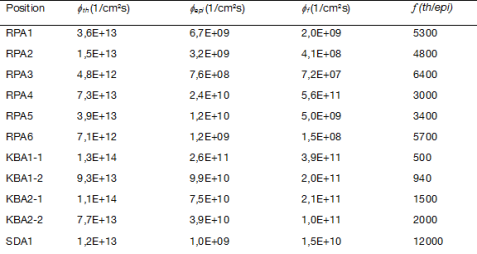MLZ is a cooperation between:
 > Technische Universität München
> Technische Universität München > Helmholtz-Zentrum Hereon
> Helmholtz-Zentrum Hereon
 > Forschungszentrum Jülich
> Forschungszentrum Jülich
MLZ is a member of:
 > LENS
> LENS > ERF-AISBL
> ERF-AISBL
MLZ on social media:

MLZ (eng)
Lichtenbergstr.1
85748 Garching
NAA
Neutron Activation Analysis (NAA)
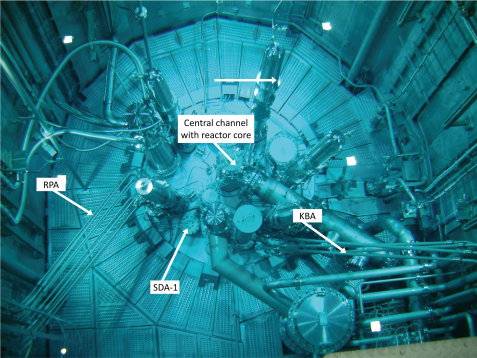
Fig. 1: Irradiation channels in the reactor pool of the FRM II. RPA: rabbit system; KBA: capsule irradiation system; KBA-1: finishing line. The fuel element is placed in the central channel about 4 meters below the platform.
When performing NAA, the sample is irradiated with neutrons; radioisotopes of the elements are formed (i. e., the so-called activation). The activated samples are then measured with gamma-ray detectors. From the activities, the masses of the elements can be determined.
For a routine NAA, samples with masses of 1 – 100 mg are packed in polyethylene bags or sealed in quartz ampoules and irradiated in one of the following channels (fig. 1) with different neutron fluxes (tab. 1).
1) For irradiations, samples are then packed in a polyethylene transport container (called rabbit, fig. 2 left) and sent into the irradiation positions near the reactor core with thermal neutron fluxes up to 4 × 1013 n cm-2s-1 using a pneumatic rabbit system (RPA). (The transport medium here is CO2 gas). Depending on the analytical task, the irradiation times are usually chosen between one minute and two hours. After irradiation, the samples are transported to the counting lab. This is located on the premises of the nearby institute Radiochemistry Munich (RCM). The typical transport time on the rabbit system is about 6 – 7 minutes. This still allows for determining short-lived nuclides, such as 28Al, 52V, 51Ti, 27Mg, etc.
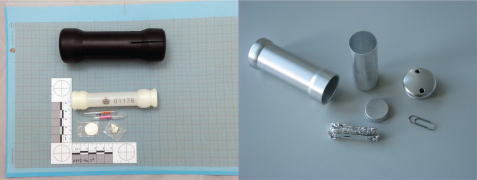
Fig. 2: Left: a PE rabbit (white) for the pneumatic system (RPA) with a few typical samples and an over-capsule (black); right: Al-rabbit for the capsule irradiation system (KBA).
2) For long irradiations of several hours up to days, the hydraulic capsule irradiation system (KBA) can be used. Samples are sealed in a transport container made of aluminium (fig. 2 right) before the irradiation because the pool water is used as the transport medium here. Due to the higher radioactivity of the transport container after long irradiations, cooling times of one or two days are usually needed. In some special cases, the container can be opened in a hot cell after irradiated. It is suitable for analysing long-lived radionuclides with very low concentrations in the samples.
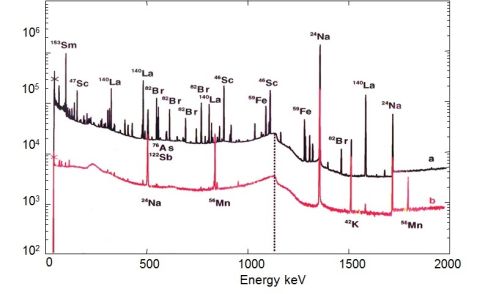
Figure 3: Gamma ray spectra of a typical NAA sample with different cooling times of 1 hour (red) and 1 day (black)
3) The “fishing line” position (SDA-1) can also be chosen for some special cases, alternatively, e. g., when samples should be cooled with pool water during the irradiation. The maximal irradiation time is limited to under one hour.
The activated samples are counted in a laboratory equipped with high-purity germanium (HPGe) detectors. Normally, the samples are measured two or three times after the irradiation. Nuclides with different half-lives can be detected fairly separately when optimising cooling and counting times (fig. 3).
A flux monitor (a gold standard) is packed and irradiated with the samples. From the activity of the gold, one can determine the neutron flux at the irradiation position. Thanks to the highly thermalised neutron field with thermal-to-epithermal flux ratios of more than 3000 in most irradiation channels, the reactions induced by epithermal neutrons can be neglected, and thus, the analysis becomes simpler and more reliable [1].
[1] Lin, X. et al., J. Radioanal. Nucl. Chem. Art. 215, 179 (1996).
- Archaeology: ‘fingerprint’-investigation of prehistoric finds, for their origin and provenance
- Life sciences: nano-particles in cells, metals in DNA
- Geo-science: ‘black smokers’ in oceans, meteorites and lunar rocks/soils
- Material science: impurities in pure materials
- Industrial applications: impurities or contaminations in silicon, plastics; analysis of compositions in ceramics, steels, alloys; waste control for heavy metals
- Art history: trace elements in pigments, identification of forgeries
- Medicine: determination of gold particles in blood during therapy
- Forensic: trace elements in tissues (famous example: As in Napoleon’s hair)
- Environmental monitoring: heavy metals in fly ash or air filters
Three high-purity Germanium (HPGe) detectors of different types are available for the gamma-counting in the NAA-lab (see gallery).
- D3: n-type HPGe Detector (HPGe = manufactured by Ortec with a 0.5 mm Be-window, coaxial, relative efficiency: 47 %
- D6: n-type HPGe Detector manufactured by Ortec with Al end cap, coaxial, relative efficiency: 28 %
- D19: n-type HPGe Detector manufactured by Canberra (now Mirion) with Al end cap, coaxial, relative efficiency: 34 %
The detectors are placed in Pb shielding and cooled with liquid nitrogen. The detector shielding suppresses the background radiation from the environment. A lining of copper and acrylic glass on the lead walls helps to shield against the X-rays induced by the gamma radiation in the lead. All lead walls have a thickness of 10 cm.
Analysis:
For the sample analysis, the k0 method is mainly used [1]. The software GENIE 2000 (Caberra/ Mirion) is used for counting. The gamma spectra are evaluated using HyperLab software, and the peak lists are processed using Kayzero for Windows to obtain the elemental masses.
NAA is non-destructive. Up to 50 elements can be determined in a sample from the major components down to the trace elements in ppm (parts per million) and even to sub-ppt (part per 1012) level (see gallery). NAA is unique for the trace-element analysis of rare-earth elements (REEs) and several other metals (e.g. Hf, Ir, Au etc.).
The detection limits also depend on the composition of the samples. Generally, light elements (Z < 11) and a few other ones (like P, Pb) cannot be analysed with NAA or just with low sensitivities (see gallery). Here, PGAA can give better results.
[1] Li, X., Lierse von Gostomski, Ch., J. Radioanal. Nucl. Chem. 300, 457 (2014).
Instrument scientists
Dr. Zsolt Revay
Phone: +49 (0)89 289-12694
E-mail: zsolt.revay@frm2.tum.de
Dr. Christian Stieghorst
Phone: +49 (0)89 289-54871
E-mail: christian.stieghorst@frm2.tum.de
PGAA
Phone: +49 (0)89 289-14906
Operated and funded by
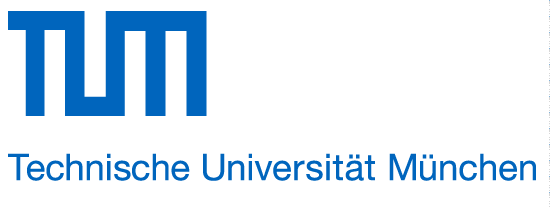
Citation templates for users
In all publications based on experiments using NAA, you must provide some acknowledgements. To make your work easier, we have prepared all the necessary templates for you on this page.
Gallery




MLZ is a cooperation between:
 > Technische Universität München
> Technische Universität München > Helmholtz-Zentrum Hereon
> Helmholtz-Zentrum Hereon
 > Forschungszentrum Jülich
> Forschungszentrum Jülich
MLZ is a member of:
 > LENS
> LENS > ERF-AISBL
> ERF-AISBL
MLZ on social media:



